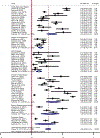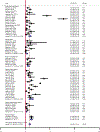Epidemiology of extensively drug-resistant tuberculosis among patients with multidrug-resistant tuberculosis: A systematic review and meta-analysis
- PMID: 37072053
- PMCID: PMC10302157
- DOI: 10.1016/j.ijid.2023.04.392
Epidemiology of extensively drug-resistant tuberculosis among patients with multidrug-resistant tuberculosis: A systematic review and meta-analysis
Abstract
Objectives: To estimate the pooled proportion of extensively drug-resistant tuberculosis (XDR-TB) and pre-extensively drug-resistant tuberculosis (pre-XDR-TB) in patients with multidrug-resistant TB (MDR-TB).
Methods: We systematically searched articles from electronic databases: MEDLINE (PubMed), ScienceDirect, and Google Scholar. We also searched gray literature from the different literature sources main outcome of the review was either XDR-TB or pre-XDR-TB in patients with MDR-TB. We used the random-effects model, considering the substantial heterogeneity among studies. Heterogeneity was assessed by subgroup analyses. STATA version 14 was used for analysis.
Results: A total of 64 studies that reported on 12,711 patients with MDR-TB from 22 countries were retrieved. The pooled proportion of pre-XDR-TB was 26% (95% confidence interval [CI]: 22-31%), whereas XDR-TB in MDR-TB cases was 9% (95% CI: 7-11%) in patients treated for MDR-TB. The pooled proportion of resistance to fluoroquinolones was 27% (95% CI: 22-33%) and second-line injectable drugs was 11% (95% CI: 9-13%). Whereas the pooled resistance proportions to bedaquiline, clofazimine, delamanid, and linezolid were 5% (95% CI: 1-8%), 4% (95% CI: 0-10%), 5% (95% CI; 2-8%), and 4% (95% CI: 2-10%), respectively.
Conclusion: The burden of pre-XDR-TB and XDR-TB in MDR-TB were considerable. The high burdens of pre-XDR-TB and XDR-TB in patients treated for MDR-TB suggests the need to strengthen TB programs and drug resistance surveillance.
Keywords: Extensively drug-resistant tuberculosis; Multidrug-resistant tuberculosis; Pre-extensively drug-resistant tuberculosis.
Copyright © 2023 The Author(s). Published by Elsevier Ltd.. All rights reserved.
Conflict of interest statement
Declaration of competing interests The authors have no competing interests to declare.
Figures








Similar articles
-
High fluoroquinolone resistance proportions among multidrug-resistant tuberculosis driven by dominant L2 Mycobacterium tuberculosis clones in the Mumbai Metropolitan Region.Genome Med. 2022 Aug 22;14(1):95. doi: 10.1186/s13073-022-01076-0. Genome Med. 2022. PMID: 35989319 Free PMC article.
-
Second-line drug resistance among multidrug-resistant tuberculosis patients in Ethiopia: A laboratory-based surveillance.J Glob Antimicrob Resist. 2025 May;42:167-174. doi: 10.1016/j.jgar.2025.02.014. Epub 2025 Feb 21. J Glob Antimicrob Resist. 2025. PMID: 39988072
-
Molecular characterization of mutations associated with resistance to second-line tuberculosis drug among multidrug-resistant tuberculosis patients from high prevalence tuberculosis city in Morocco.BMC Infect Dis. 2018 Feb 27;18(1):98. doi: 10.1186/s12879-018-3009-9. BMC Infect Dis. 2018. PMID: 29486710 Free PMC article.
-
Systematic review of clofazimine for the treatment of drug-resistant tuberculosis.Int J Tuberc Lung Dis. 2013 Aug;17(8):1001-7. doi: 10.5588/ijtld.12.0144. Epub 2013 Mar 25. Int J Tuberc Lung Dis. 2013. PMID: 23541151 Free PMC article.
-
Pre-extensively drug-resistant and extensively drug-resistant tuberculosis in Latin America and the Caribbean: A systematic review and meta-analysis.Am J Infect Control. 2024 Mar;52(3):349-357. doi: 10.1016/j.ajic.2023.12.001. Epub 2023 Dec 6. Am J Infect Control. 2024. PMID: 38061402
Cited by
-
Second-line drug-resistant TB and associated risk factors in Karakalpakstan, Uzbekistan.IJTLD Open. 2024 Sep 1;1(9):391-397. doi: 10.5588/ijtldopen.24.0351. eCollection 2024 Sep. IJTLD Open. 2024. PMID: 39301133 Free PMC article.
-
Evaluation of Diagnostic Methods and Rifampicin Resistance in Pulmonary Tuberculosis: A Hospital-Based Study.Cureus. 2024 Aug 17;16(8):e67062. doi: 10.7759/cureus.67062. eCollection 2024 Aug. Cureus. 2024. PMID: 39286711 Free PMC article.
-
Clinical effects of detailed nursing management interventions on medication adherence and disease perception in patients with drug-resistant tuberculosis.World J Clin Cases. 2024 Jul 16;12(20):4191-4198. doi: 10.12998/wjcc.v12.i20.4191. World J Clin Cases. 2024. PMID: 39015906 Free PMC article. Clinical Trial.
-
Multidrug Resistance Tuberculosis in the Context of Co-Infection in Ethiopia: A Systematic Review and Meta-Analysis.J Epidemiol Glob Health. 2025 Feb 5;15(1):19. doi: 10.1007/s44197-025-00360-7. J Epidemiol Glob Health. 2025. PMID: 39909956 Free PMC article.
-
Evaluation of Sulfasalazine as an Adjunctive Therapy in Treating Pulmonary Pre-XDR-TB: Efficacy, Safety, and Treatment Implication.Infect Drug Resist. 2024 Feb 17;17:595-604. doi: 10.2147/IDR.S443897. eCollection 2024. Infect Drug Resist. 2024. PMID: 38390619 Free PMC article.
References
-
- World Health Organization. Global Tubeclosis report 2020.
-
- World Health Organization Global Tubeclosis report. Geneva: World Health Organization; 2022.
-
- World Health Organization Global tuberculosis report. Geneva: World Health Organization; 2019.
Publication types
MeSH terms
Substances
Grants and funding
LinkOut - more resources
Full Text Sources

